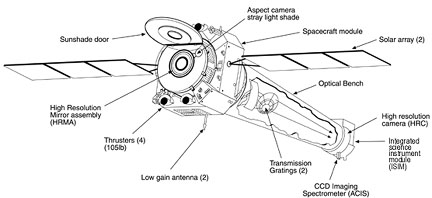X-RAY CENTER
Harvard-Smithsonian Center for Astrophysics
60 Garden Street, Cambridge, MA 02138
Chandra Specifications
For more information visit:
http://chandra.harvard.edu

|
CHANDRA X-RAY CENTER Harvard-Smithsonian Center for Astrophysics 60 Garden Street, Cambridge, MA 02138 |
June, 2000 Chandra Specifications For more information visit: http://chandra.harvard.edu |

|
NASA's Chandra X-Ray Center |
|

An X-ray telescope is the only way astronomers can observe
the hot regions of the universe. The most powerful optical
telescopes, such as the Hubble Space Telescope, cannot see
the vast clouds of hot gas that stretch millions of light
years across and contain enough matter to make hundreds of
trillions of stars. X-ray telescopes allow us to image matter
swirling as close as 90 kilometers from the event horizon of
a stellar black hole or to track the expansion of a hot gas
bubble produced by an exploding star.
Chandra is the third of NASA's Great Observatories. The
mirrors on Chandra are the largest, most precisely shaped and
aligned, and smoothest mirrors ever constructed. The images
Chandra makes are twenty-five times sharper than the best
previous X-ray telescope. Chandra, which was launched by the
Space Shuttle on July 23, 1999, is helping scientists to
better understand the hot, turbulent regions of space and
answer fundamental questions about the origin, evolution, and
destiny of the universe.
|
|
|
|
||||||||||||||||||||||||||||||||

|
|
|
||||||||||||||||||||||||||||||||||||
|
Marshall Spaceflight Center |
Astrophysical Observatory |